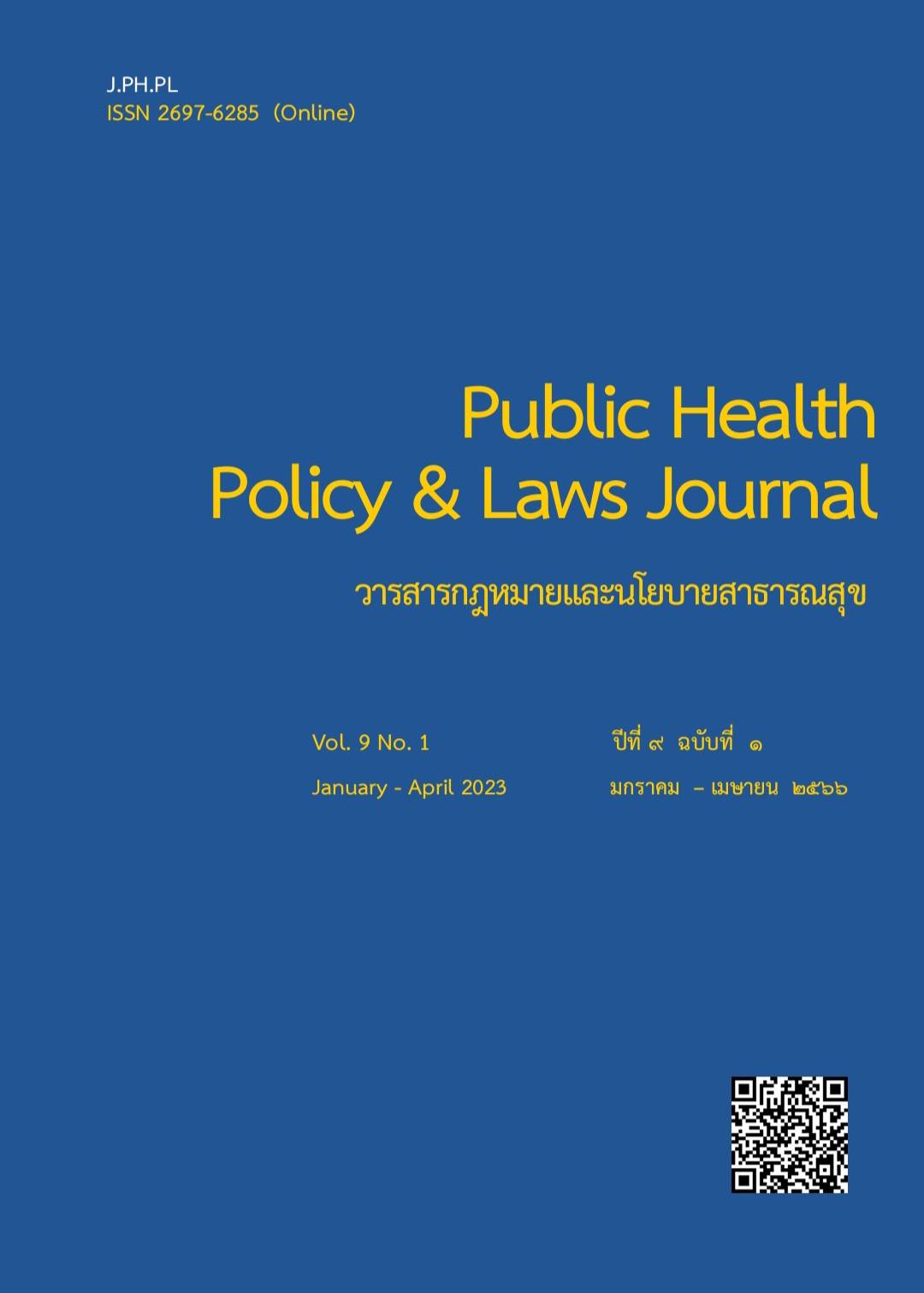Sexual Health Literacy among Secondary School Students in Chonburi Province
Keywords:
health literacy, sexual health, early adolescenceAbstract
Adolescence is a period of feeling in love and sexual development. Promoting the sexual health literacy among adolescences is mandatory to decrease risks on sexual behaviors. The purpose of this cross-sectional survey research was to examine the sexual health literacy and associated factors among Mathayom Suksa 1-3 levels students, in Chonburi Province. Data collection was accomplished using a self-administered questionnaire. The sample consisted of 333 students. The data were analyzed using independent samples t test, One-way ANOVA, and Pearson’s product moment correlation. The statistical significance level was determined at p-value of 0.05.
The crucial findings revealed that 220 of the Mathayom Suksa students (66%) had overall sexual health literacy at low level. Mathayom Suksa 2 and 3 levels students had the overall sexual health literacy score higher than Mathayom Suksa 1 level students, with statistical significant (p < 0.05). Factors significantly associated with the overall sexual health literacy (p < 0.001) were sexual health knowledge resources namely, social media, friend, school, and family (r = 0.40, 0.38, 0.33, and 0.21, respectively) GPA (r = 0.21), and self-esteem (r = 0.18).
The findings lead to the recommendations that schools should have the social media materials content on the teenage sexual health, and risk factors of adolescence. This information should be publicized on the school’s online network, such as the school’s parents or students line group, and school’s Facebook. Surveillance and monitoring the sexual risk behavior of students, especially the Mathayom Suksa 1 level, and those with low GPA.
References
กระทรวงสาธารณสุข. (2562). สถานการณ์อนามัยการเจริญพันธุ์ในวัยรุ่นและเยาวชน. นนทบุรี: สำนักอนามัยเจริญพันธุ์ กรมอนามัย กระทรวงสาธารณสุข.
กลุ่มพัฒนาระบบเฝ้าระวังทางระบาดวิทยาโรคเอดส์ วัณโรค และโรคติดต่อทางเพศสัมพันธ์ สำนักระบาดวิทยา. (2562). รายงานผลการเฝ้าระวังพฤติกรรมที่สัมพันธ์กับการติดเชื้อเอชไอวี กลุ่มนักเรียน ประเทศไทย ปี พ.ศ.2561. พิมพ์ครั้งที่ 1. นนทบุรี: สำนักระบาดวิทยา กรมควบคุมโรคกระทรวงสาธารณสุข.
คลังพลอย เอื้อวิทยาศุภร, อรณิชา โพธิ์หมื่นทิพย์. (2554). ความรู้และทัศนคติเกี่ยวกับพฤติกรรมเสี่ยงทางเพศของวัยรุ่น อำเภอเมือง จังหวัดนครราชสีมา. วารสารวิทยาลัยพยาบาลบรมราชชนนี นครราชสีมา. 17(2): 15-26.
บรรจง พลไชย. (2554). พฤติกรรมทางเพศของนักเรียนชั้นมัธยมศึกษาปีที่ 5 ในโรงเรียนมัธยมศึกษาแห่งหนึ่งในเขตเทศบาลเมืองนครพนม. วารสารศูนย์การศึกษาแพทยศาสตร์คลินิก โรงพยาบาลพระปกเกล้า. 28(4): 230-237.
ปริยานุช ตั้งนรกุล, ศิริยุพา สนั่นเรืองศักดิ์, นฤมล ธีระรังสิกุล. (2562). ความสัมพันธ์ระหว่างความรอบรู้ด้านสุขภาพทางเพศกับพฤติกรรมทางเพศของนักเรียนหญิงชั้นมัธยมศึกษาตอนต้น. วารสารแพทย์นาวี. 46 (3): 607-620.
วรรณศิริ ประจัน, รุ่งรัตน์ ศรีสุริยเวศน์, พรนภา หอมสินธุ์. (2560). ปัจจัยที่มีผลต่อพฤติกรรมทางเพศของนักเรียนประถมศึกษาตอนปลายตามแนวคิดการให้ข้อมูลข่าวสารแรงจูงใจและทักษะพฤติกรรม. วารสารพยาบาลศาสตร์ จุฬาลงกรณ์มหาวิทยาลัย. 29(2): 39-51.
วารุณี สอนอินทร์. (2558). บทบาทของพยาบาลอนามัยโรงเรียนในการส่งเสริมการเห็นคุณค่าในตนเองเพื่อป้องกันพฤติกรรมเสี่ยงทางเพศของวัยรุ่นหญิงตอนต้น. วารสารพยาบาลสภากาชาดไทย. 8(2): 62-71.
วิมล โรมา, ชะนวนทอง ธนสุกาญจน์, มธุรส ทิพยมงคลกุล, ณัฐนารี เอมยงค์, นรีมาลย์
นีละไพจิตร, มุกดา สำนวนกลาง, สายชล คล้อยเอี่ยม. (2561). รายงานฉบับสมบูรณ์ โครงการสำรวจความรอบรู้ด้านสุขภาพของประชาชนไทย อายุ 15 ปี ขึ้นไป พ.ศ. 2560 (ระยะที่ 1). นนทบุรี: กรมอนามัย กระทรวงสาธารณสุข.
วิไลลักษณ์ วงศ์อาษา, ปิยะพร กองเงิน, สารารัตน์ วุฒิอาภา. (2558). ปัจจัยที่มีผลต่อพฤติกรรมเสี่ยงทางเพศในวัยรุ่นหญิง กรณีศึกษามหาวิทยาลัยแห่งหนึ่ง. วารสารสาธารณสุขศาสตร์. 45(3): 285-297.
ศันสนีย์ ณรงค์ศักดิ์ภูติ. (2559). พฤติกรรมการดูแลสุขภาพทางเพศและอนามัยเจริญพันธุ์และการจัดการตนเองเมื่อมีปัญหาทางเพศและอนามัยเจริญพันธุ์ของวัยรุ่นเร่ร่อนในเขตกรุงเทพมหานคร. วิทยานิพนธ์ปริญญาพยาบาลศาสตรมหาบัณฑิต. กรุงเทพฯ. มหาวิทยาลัยธรรมศาสตร์.
สุดารัตน์ บุญเทียม, รุ่งรัตน์ศรีสุริยเวศน์, พรนภา หอมสินธุ์. (2558). ปัจจัยทำนายเกี่ยวกับต้นทุนชีวิตต่อพฤติกรรมทางเพศที่พึงประสงค์ในวัยรุ่นชายตอนต้น จังหวัดชลบุรี. วารสารการพยาบาลและการศึกษา. 22(2): 72-84.
สุมิตตา สว่างทุกข์. (2558). การศึกษาการตระหนักรู้ในพฤติกรรมเสี่ยงทางเพศกับพฤติกรรมเสี่ยงทางเพศของนักเรียนวัยรุ่น. วารสารเกื้อการุณย์. 22(2): 41-56.
อุทัยวรรณ สกุลวลีธร, ศิริยุพา สนั่นเรืองศักดิ์, นฤมล ธีระรังสิกุล. (2561). ปัจจัยทำนายพฤติกรรมป้องกันความเสี่ยงทางเพศในวัยรุ่นหญิงมัธยมศึกษาตอนต้น. วารสารวิชาการมหาวิทยาลัยอีสเทิร์นเอเชีย ฉบับวิทยาศาสตร์และเทคโนโลยี. 12(2): 253-264.
Manganello AJ. (2008). Health Literacy and Adolescents: A Framework and Agenda for Future Research. Health Education Research. 23(5): 840–847.
Martin, P Susan (2017). Young People’s Sexual Health Literacy: Seeking, Understanding, and Evaluating Online Sexual Health
Information. PhD Thesis. Scotland: University of Glasgow. [Internet] [Cited 2019 Jan 6]. Available from: https://theses.gla.ac.uk/8528/7/2017MartinPhD.pdf.
Naidoo S, Taylor M. (2015). HIV Health Literacy: Sexual Behavior and Self-Reports of Having Tested for HIV among Students. African Journal of AIDS Research. 14(2): 107-115.
O’Sullivan FL, Byer E, Brotto AL, Majerovich AJ. (2015). Access to and Use of Sexual Health Care Services among Young Canadians with and without A History of Sexual Coercion. Canadian Family Physician. 61:e467-473.
Rosenberg M. (1965). Society and the Adolescent Self-Image. Princeton, NJ: Princeton University Press.
Wayne, W Daniel. (2009). Biostatistics: A Foundation for Analysis in the Health Sciences. 9th ed. USA: John Wiley & Sons Inc.
World Health Organization. (2006). Sexual and Reproductive Health: Defining Sexual Health. [Internet]. [Cited 2018 Dec 28]. Available from: https://www.who.int/reproductivehealth/topics/sexual_health/sh_definitions/en.
Downloads
Published
How to Cite
Issue
Section
License
Disclaimer and Copyright Notice
The content and information presented in articles published in the Journal of Law and Public Health Policy represent the opinions and sole responsibility of the respective authors. The editorial board does not necessarily agree with or assume any responsibility for the views expressed.
All articles, data, content, images, and other materials published in the Journal of Law and Public Health Policy are the intellectual property of the journal. Any individual or organization wishing to reproduce, distribute, or otherwise use the entirety or any part of such materials must provide proper citation.





